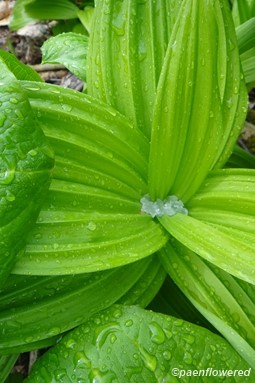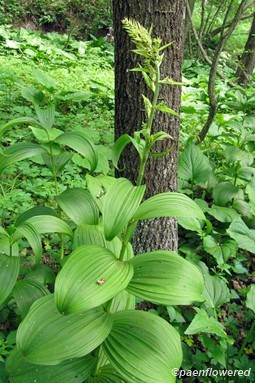Veratrum viride
Rhizomatous perennial herb with pubescent stem
Veratrum viride false hellebore
The easiest way to identify this species is by noting the heavy parallel veins on large alternate yellow-green clasping leaves. These are most conspicuous in early spring when they first emerge and grow six to twelve inches long. The plant is stout and grows two to seven feet tall. The flowers are interesting but not easily seen from a distance because they begin as a yellow-green color and become dull green later. Each is about 2/3 inch wide. They are star-shaped with three petals and three petal-like sepals. There are six curved stamens. They are bourn in large branched clusters 8-20 inches tall.
The fruit is a capsule. The false hellebore is found in swamps and wet woodlands. It occurs from southeastern Canada and in northeastern United States south to Maryland and Tennessee and to Alabama and Georgia in the uplands. It is also found in Alaska and the American Northwest. It blooms from May to July and then withers away. The roots and leaves are poisonous, and the leaves can be deadly if eaten. They have a burning taste and so are usually avoided by animals. It is said that among certain Native American tribes, chiefs could only be selected if they survived eating this plant. It also has the common name of Indian Poke. The plant called the Helleborine is actually an orchid with a flower spike superficially like the false hellebore and also has greenish flowers.
Habitat & Range
Frequent in wet woods, stream banks, boggy areas.
Present throughout the state.
Range: Southeastern Canada; Northeastern US south to Maryland and Tennessee and to Alabama and Georgia in the uplands.
| EMP: | FACW |
|---|---|
| NCNE: | FACW |
Phenology
Flowers in May.
Plant Codes
S-rank: No rank
G-rank: G5 (Secure)





.jpg?v=638487562590000000)
.jpg?v=638488220850000000)




.jpg?v=638211805320000000)
Comments
Have you spotted this plant in your area? We'd love to hear about your experience! Share your comments or questions about the plant below. Comments are moderated before posting.